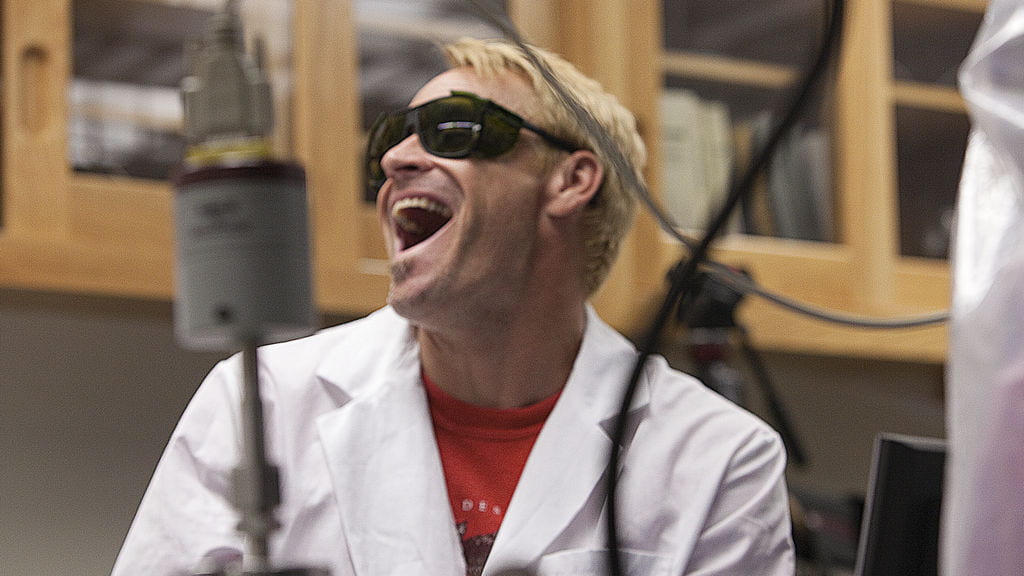AirUCI gets teachers pumped up about chemistry
AirUCI summer workshop aims to inspire seventh- to 12th-grade science teachers so they can inspire their own students.

Mickey Laux, Ph.D. ’96, a chemistry professor at Orange Coast College,
is so good at teaching he makes even the inner workings of a quadrupole
mass spectrometer sound interesting. To demonstrate how a positively
charged ion moves inside the spectrometer’s positively and negatively
charged rods, for instance, he draws on his best “Titanic” imitation,
frantically steering the doomed ocean liner away from the berg.
“I’m the master of terrible analogies,” he says, laughing. Yet his
students — most of them chemistry teachers from Orange County middle
and high schools — learn not only a difficult scientific concept but a
larger lesson: how to get their own students excited about science.
“I want to teach like Mickey when I grow up,” one jokes.
Laux’s mass spectrometer lecture at UC Irvine is just a small part of the AirUCI Summer Workshop in Environmental Chemistry for Science Teachers, which he organizes annually with Sergey Nizkorodov, associate professor of chemistry. Funded by the National Science Foundation, the two-week program began in 2005 to improve chemistry education in seventh through 12th grade; 117 teachers so far have participated.
“We wanted to get teachers excited about science by focusing on fundamental chemistry and the latest air research. We wouldn’t presume to try to teach them how or what to teach,” says chemistry professor Barbara J. Finlayson-Pitts, AirUCI director and chemistry professor. “Deepening their knowledge turned out to be exactly the right thing to do.”
Every summer, about 20 teachers attend presentations by Laux and UCI faculty members, giving them a rare opportunity to learn about air pollution, the Antarctic ozone hole, climate change and other topics from pioneers in those areas. Guest lecturers have included UCI’s F. Sherwood Rowland, winner of the 1995 Nobel Prize in chemistry; Donald Blake, a leading expert on atmospheric gases; and James N. Pitts Jr., co-founder and past director of the University of California Statewide Air Pollution Research Center.
“Faculty members, graduate students, postdoc researchers — everyone at AirUCI participates in the program. We really see this as important,” Finlayson-Pitts says.
Although most attendees are from Orange County schools, the workshop draws teachers from around the U.S. All receive a $1,000 stipend and UCI Extension credits for professional development.
“I traveled across the country to be here because there aren’t a lot of programs like this,” says Connie Boone, a high school chemistry teacher from Jacksonville, Fla. “These are people whose names appear in science journals. They could just stay in their labs and do their research, but instead they want to share their knowledge with us — and that includes my students.”
The program also allows teachers to conduct experiments in UCI’s world-class labs using state-of-the-art equipment — a luxury for those coming from cash-strapped schools. “It’s not just canned science,” Finlayson-Pitts says. “This gives them experience at the highest level that they can pass on to their classes.”
During a recent session, attendees took turns blasting a lithium battery with a high-powered laser to study its contents. “Most high school teachers have never seen a laser, let alone used one,” Laux says.
They’ve also analyzed cigarette smoke and exhaust from their cars’ tailpipes. Nizkorodov even had them perform experiments for his research on household air purifiers that showed certain ones emitted unhealthy levels of ozone.
“We often have the teachers tell us, ‘This is the best program we’ve ever attended, because we learned something new,'” Finlayson-Pitts says. A National Academy of Sciences committee has recognized the AirUCI workshop as one of four exemplary K-12 outreach programs in the U.S.
After the workshop ends, AirUCI follows up with teachers to gauge the training’s impact. Teachers have reported that the program deepened their scientific knowledge, inspired them to update their curricula and altered their teaching style.
“We teach 20 students, and we estimate each teaches 150 students a year. So the program has affected tens of thousands of students at different levels,” Finlayson-Pitts says.
Laux, the self-proclaimed “master of terrible analogies,” puts it this way: “The program offers a lot of bang for the buck. It’s like compounding interest.”